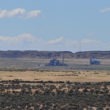President Trump’s recently released Nuclear Posture Review reflects an enduring struggle by the U.S. nuclear weapons establishment to fit into the post–Cold War world. For decades following World War II, the United States and the Soviet Union built grossly oversized nuclear arsenals and never envisioned having to stop. The perverse logic of this nuclear rivalry reached a point of ultimate absurdity during the first Reagan administration—when the notion that the winner of a nuclear war would be the one with the most weapons left over was baked into U.S. nuclear weapons policy.
After churning out tens of thousands of nukes, toward the end of the 1980s the U.S. nuclear weapons research and development and industrial base collapsed from age and neglect. The demise of the Soviet Union in 1991 and a voluntary moratorium on nuclear testing led to a major downsizing of U.S. nuclear capabilities, conveying unwelcome news for the weapons laboratories that had been operating at a feverish pace for so long to provide future sustainability for the whole complex. Since 1989, no new U.S. nuclear weapons have been produced, though modifications have provided big increases in capability.
Over the past 32 years, U.S. and Russian nuclear arsenals have been cut by about 80 percent and 89 percent respectively. According to the Federation of American Scientists, the U.S. and Russia continue to stockpile some 4,000–4,300 for use: constituting roughly 88 percent of all nuclear weapons in the world. This decline in absolute numbers, however, has not slowed the pace of nuclear weapons modernization, a process that has led to increased accuracy and ongoing strategic reliance on these weapons well into the 21st century.
Make no mistake—the end of the Cold War has had little impact on the catastrophes these weapons of mass destruction can inflict. Currently, Russia and the United States each have roughly 1,300–1,500 nuclear warheads in high alert, with the genocidal potential of nearly 400 times the total explosive power of all weapons used during World War II.
Much of the Trump nuclear strategy document mirrors those of the Obama and G.W. Bush administrations, most notably the goal to achieve a very costly modernization of the U.S. nuclear weapons arsenal and production complex. In a departure from Obama, who found that the greatest danger was “a terrorist attack with a nuclear weapon,” Trump’s nuclear strategy calls for a flexible nuclear warfare capability in a world populated with existential threats, including Iran, Russia, China, North Korea, as well as those who launch large-scale cyber-attacks against vital infrastructures – thereby introducing a new and unprecedented rationale for nuclear war.
While the Trump document raises the stakes for the use of nuclear weapons, it’s not the first to do so. For instance, the Nuclear Posture Review issued in 2002 during the G.W. Bush administration listed six countries in addition to Russia for nuclear targeting, including Syria, Iraq, North Korea, Iran, China, and Libya. Like the Trump strategy, it also called for the development of low-yield weapons to destroy underground tunnels and bunkers. Calling for a shortening of the period before resumption of nuclear testing, Bush’s review rejected key nuclear arms control agreements such as the Anti-Ballistic Missile treaty (ABM) and the Comprehensive Nuclear Test-Ban Treaty (CTBT).
The actual implementation of Bush’s nuclear weapons policy turned out quite differently. During his tenure, he presided over one of the largest unilateral nuclear weapons cuts—retiring more than 5,000 warheads. Bush took the inventory down to half its size—a level not seen since the Eisenhower administration. Bush fared less well in his quest for new nuclear warhead designs, which were rejected by a Republican-controlled Congress. And Obama’s own efforts to make further significant cuts were blocked by Congress during a time of enhanced partisanship.
Usable, low-yield nuclear weapons are key assets in dealing with the dangerous world envisioned by Trump, as they were in the Bush doctrine. U.S. nuclear weapons laboratories have been marketing such weapons for several decades, but the Bush administration could not convince a Republican-controlled Congress to fund them.
Usable, low-yield nuclear weapons are key assets in dealing with the dangerous world envisioned by Trump, as they were in the Bush doctrine.
Left at the end of the Cold War with large-yield strategic nuclear weapons designed to destroy Soviet missile silos, government nuclear analysts raised the alarm that the U.S. arsenal was at risk of becoming a “self-deterred” anachronism. (During the Cold War, nuclear weapons planners saw “self-deterrence” between the United States and the Soviet Union as a stabilizing element, in which both sides moderated their behavior in recognition of the catastrophic outcomes of a nuclear exchange.)
The rationale was that the outdated Cold War nuclear arsenals had questionable value for the United States in deterring “rogue” nuclear adversaries that were equipped with smaller, less destructive nuclear weapons. The solution, they argued, was to deploy small-yield weapons, then known as “bunker busters,” that would free the United States from the Cold War shackles of self-deterrence. In his own crude fashion, Trump raised the same concern in August 2016 by asking, “If we have them, why can’t we use them?” It’s also been suggested that one of the major reasons why low-yield weapons systems are being promoted is that they provide a raison d’être for the weapons laboratories, offering the promise of additional long-term funding and a more ambitious mission than merely maintaining the functionality of a shrinking nuclear stockpile.
After endorsing “mini-nukes” in its 2002 Nuclear Posture Review, the Bush administration had to overcome a legislative roadblock passed in 1994 barring the design and development of low-yield nuclear weapons. Congress obligingly lifted the ban in 2004, allowing design work for the “Robust Earth Penetrator,” with the proviso that the Energy Department could not proceed to the engineering stage without congressional approval, which was never granted. It wasn’t until President Obama’s tenure, in 2016, that engineering low-yield nukes proceeded with congressional acquiescence, clearing the way for deployment of the modernized B61-12 warhead. With a “tunable” yield, the B61-12 is a guided bomb deployed on aircraft and can be dialed down to 300 tons of explosive power.
Small-yield nuclear weapons for use on the battlefield are nothing new. Between the late 1950s and the late 1980s, the United States fielded hundreds of low-yield tactical weapons in Europe and South Korea. These include 15 different warhead designs that were deployed on missiles, artillery shells, and even a bazooka, known as the “Davy Crockett,” that had a yield of 10-20 tons. They all proved to be unwieldy and are long gone.
Obscured in the promotion of low-yield nukes is the basic fact that they are also lethal radiological weapons capable of poisoning large areas with radioactive fallout. This has been known since the first nuclear test in New Mexico on July 16, 1945, when the device exploded 100 feet above the ground and then contaminated thousands of square miles with highly radioactive soil that was lifted into the bomb cloud.
By legitimizing low-yield nuclear weapons, Trump’s strategy provides cover for nations, particularly Pakistan, to mass-produce them. Pakistan is producing new nuclear weapons at a faster pace than any country in the world. Over the next five to ten years, it is estimated that Pakistan will have nearly 350 nuclear warheads, mostly of the low-yield classification.
By placing nuclear-tipped cruise missiles on submarines, the Trump proposal seeks to reverse a 25-year effort that removed of all tactical nukes from U.S. Naval vessels by 2013. Some experts say that navy officials were glad to be rid of them because of both their cost and cumbersome requirements. Alarmingly however, Russia and several other nations such as China, Pakistan and India are preparing to step up deployment of their own submarine launched nuclear cruise missiles. Defenses against these weapons are extraordinarily expensive and tenuous at best. With the spread of these weapons, greatly increased numbers of anti-submarine convoys using aircraft, satellites and naval assets, including tanker and fighter patrols would have to operate around the clock keeping watch over the world’s vast oceans.
Like Obama, Trump is continuing to spend billions-of dollars on long-range “standoff” nuclear cruise missiles to be launched from aircraft out of range from air defenses. William Perry, former Defense Secretary under president Clinton finds them to be destabilizing because they “short circuit deterrence by increasing their use in combat.” Already considered to be a highly desirable conventional first strike weapon, cruise missiles are used mostly against air defenses in the early stages of conflict. They are extremely accurate and fly low enough to evade radar systems. Perry says “the U.S. plan to create 1,000 of these missiles shuts the door on the possibility of a global ban.”
The most striking example of how the Trump NPR inflates the threat of a nuclear Armageddon to justify its more aggressive stance is the document’s reference to Russia’s long-range, self-guided nuclear torpedo. News about this new and extremely dubious weapon was leaked under suspicious circumstances by Russia in 2015. With a yield as large as 100 megatons, and salted with highly radioactive cobalt-60, the torpedo is touted to be able to destroy an entire coastal zone, while leaving behind an enormous swath of deadly radiological contamination that would last for centuries.
Setting aside the technical obstacles of traveling 6,200 miles underwater, a distance that can much more easily be accomplished by an airborne intercontinental ballistic missile, this is a very heavy, noisy, and untested torpedo that will take several days to reach its target while maneuvering the mountainous underwater terrain. For these reasons, the United States abandoned long-range nuclear torpedoes decades ago.
Jeffrey Lewis, an arms-control scholar specializing in nonproliferation and geopolitics, currently at the Middlebury Institute in Monterey, California, observed in 2015, “At the risk of understating things, this project is bat-shit crazy. It harkens back to the most absurd moments of the Cold War, when nuclear strategists followed the logic of deterrence over the cliff and into the abyss.”
The most difficult challenge that has faced all presidents since the end of the Cold War is the cost and management of modernizing the nuclear arsenal and production complex. A recent Congressional Budget Office estimate puts the bill for modernization at $1.2 trillion over 30 years. This is fast becoming a budgetary millstone, which threatens to grow even larger, consuming funds that impact the conventional military requirements. Even though the U.S. nuclear weapons stockpile has shrunk by 60 percent since 2003, the annual per-warhead maintenance cost has increased by about 422 percent and continues to go up.
Apparently, shrinkage of the U.S. nuclear stockpile does not sit well with Trump, who has repeatedly called for its expansion. In the summer of 2017, after being shown a slide tracking the reduction of the nuclear stockpile since the Cold War at a Pentagon briefing, Trump was reported to be upset and, according to NBC news, demanded a tenfold increase in the size of the U.S. nuclear arsenal. Trump’s outburst surprised—some might say shocked—the military and State Department officials, as he apparently couldn’t grasp the vast destructiveness of the existing weaponry. It was shortly after this meeting that The New Yorker reported Secretary of State Rex Tillerson described his boss as a “fucking moron.”
A significant buildup of nuclear weapons is not only costly, it’s redundant. Moreover, because of the decline of the U.S. nuclear production infrastructure 30 years ago, it is unlikely to happen. In 2009, a Defense Department advisory committee succinctly described this situation, stating: “Neglect has produced an all but vanished nuclear weapons industrial base, an aged and sporadically exercised weapons complex.” The projected timeline to reach production beyond a few dozen new nuclear weapons per year is 20–30 years.
Human skills are among the most important factors necessary to meet nuclear weapons production goals. Thomas D’Agostino, former under secretary for nuclear security at the Department of Energy, believes that within five years the United States will have lost all engineers who had “a key hand in the design of a warhead that’s in the existing stockpile.” Currently, about half of the employees with the critical skills to maintain the U.S. nuclear weapons stockpile are close to retirement.
And because making the most dangerous weapons in the world involves working with some of the most dangerous materials, these are jobs that require a very high degree of protection against exposure to one-of-a-kind, high-hazard technologies. The United States is already paying a stiff price for the harm caused to the workforce that made nuclear weapons through the early 1980s. To date, $14.56 billion has been paid in compensation and medical care for 118,244 deceased and sick nuclear weapons workers.
The environmental legacy of nuclear weapons is an issue conspicuously absent from any strategic nuclear policy discussion. U.S. nuclear weapons sites—many of them under the aegis of the DOE—constitute some of the most contaminated zones in the Western hemisphere. The environmental cleanup effort is the most costly, complex, and risky ever undertaken. Site remediation and disposition of radioactive detritus—estimated to cost between $500 billion and $1 trillion—are expected to continue well into this century. After that, long-term stewardship of profoundly contaminated areas will pose a challenge spanning hundreds of centuries.
Based on growing evidence from White House staff, it’s unlikely that Trump has bothered to read his nuclear policy statement or has even been briefed on it, except for possibly seeing it discussed on Fox News. But this much is certain: nuclear posture reviews are not carved in stone. In 2010, President Obama’s review stated that it would “reduce the role and numbers of nuclear weapons with a long-term goal of a nuclear-free world.” However, in order to get defense hawks in the Senate to approve the New START agreement with Russia, Obama reversed course by dramatically increasing spending on the modernization of the nuclear arsenal and production complex—enabling the presence of many nuclear weapons well into the future. George W. Bush failed to meet key policy goals of his review, though ultimately he made deep cuts in the size of the nuclear arsenal. While these documents offer a useful opportunity to conduct a wider public discussion of consequential policy issues, there is a likelihood that the ideas outlined in Trump’s Nuclear Posture Review will be held hostage to congressional dysfunction, budget realities, and elections.
A senior scholar at the Institute for Policy Studies, Robert Alvarez served as senior policy adviser to the Energy Department’s secretary and deputy assistant secretary for national security and the environment from 1993 to 1999. During this tenure, he coordinated the Energy Department’s nuclear material strategic planning and established the department’s first asset management program.







thanks
Thanks for the informative articles on the subject that public ignorance of is an existential threat to humanity by itself, Robert Alvarez!